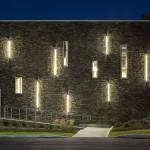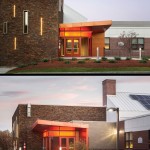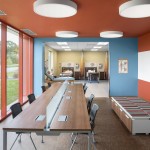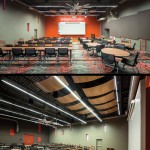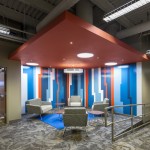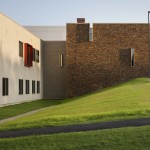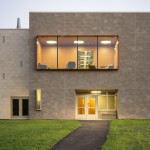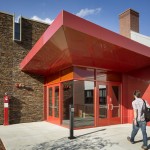LRCC Health and Science Building Addition
Project Name: LRCC Health and Science Building Addition
Bringing STEM classrooms and simulation learning environments to a growing, rural community college with a tight budget poses significant challenges.
The Health and Science Building is a 24,450 SF, two-story addition that was achieved for $227/s.f. It contains chemistry, physics, and biology laboratories, a fire sciences training lab with simulated sprinkler systems, burn hoods, EMT training facilities and a nursing simulation lab that recreates the hospital environment. The building also features an academic commons space with flexible tiered seating that can accommodate up to 300.
Laboratory and simulation buildings are inherently energy intensive. The systems for this building utilize heat recovery, a high performance envelope, and high efficiency mechanical equipment to minimize operation costs. Solar tube skylights bring light to interior collaborative spaces, and the labs feature window views of the local mountains.
The great challenge of this project was to maintain a robust program while keeping the budget in check. Material selection and application were crucial to maximizing funds. The exterior is porcelain tile, economically cladding most of the addition. We studied this tile extensively for performance in the local environment. A pattern of “ticks” was derived from the spacers between drying stacks of lumber seen in many of the local lumber mills. The academic commons is clad in a thin stone with slate colors that relate to the other two buildings on campus and reference the local mountains.
The LED exterior strip lights, embedded into the façade, act as a beacon for evening community events and also evoke a call to learn. The bold entry canopy, in a dichroic orange/red, clearly denotes the entry, and to some it is reminiscent of the racing finishes applied by students in the automotive department.
To create a more custom appearance on the limited budget, careful thought went into where “splurges” in material would make the largest impact. These included a custom carpet in the commons and large windows in the exterior lounge spaces.
Throughout the building, small nooks create student lounge areas, featuring decorative wall patterns that double as writable surfaces. In classrooms and labs, entire walls function as white boards and all furniture is on wheels to allow for adaptability. At the dedication of the building, a faculty member from the design committee remarked, “on this campus I know we teach, but in this building I feel like I want to learn.”


